Guide to safety when working at height | ERIKS shop NL

Nội Dung Chính
Safety when Working at Height
Although hand and arm injuries are the most common type
of workplace accidents, falls due to working at height are also a major reason of concern for employers. The number of workplace accidents caused by slipping
or stumbling and falling from height reached 587.739 accidents in 2016 in the European
Union, men being twice as affected as women.
In The Netherlands, there were 17.487 work accidents caused by falling in 2016, in Belgium the number reached 15.747, in Germany there were 162.833 accidents and in Switzerland 16.985 accidents. In the UK, the number of accidents caused by falling at work was 68.058, and in France there were 126.871 in 2016.
In what concerns the most affected industries, the number are as follows:
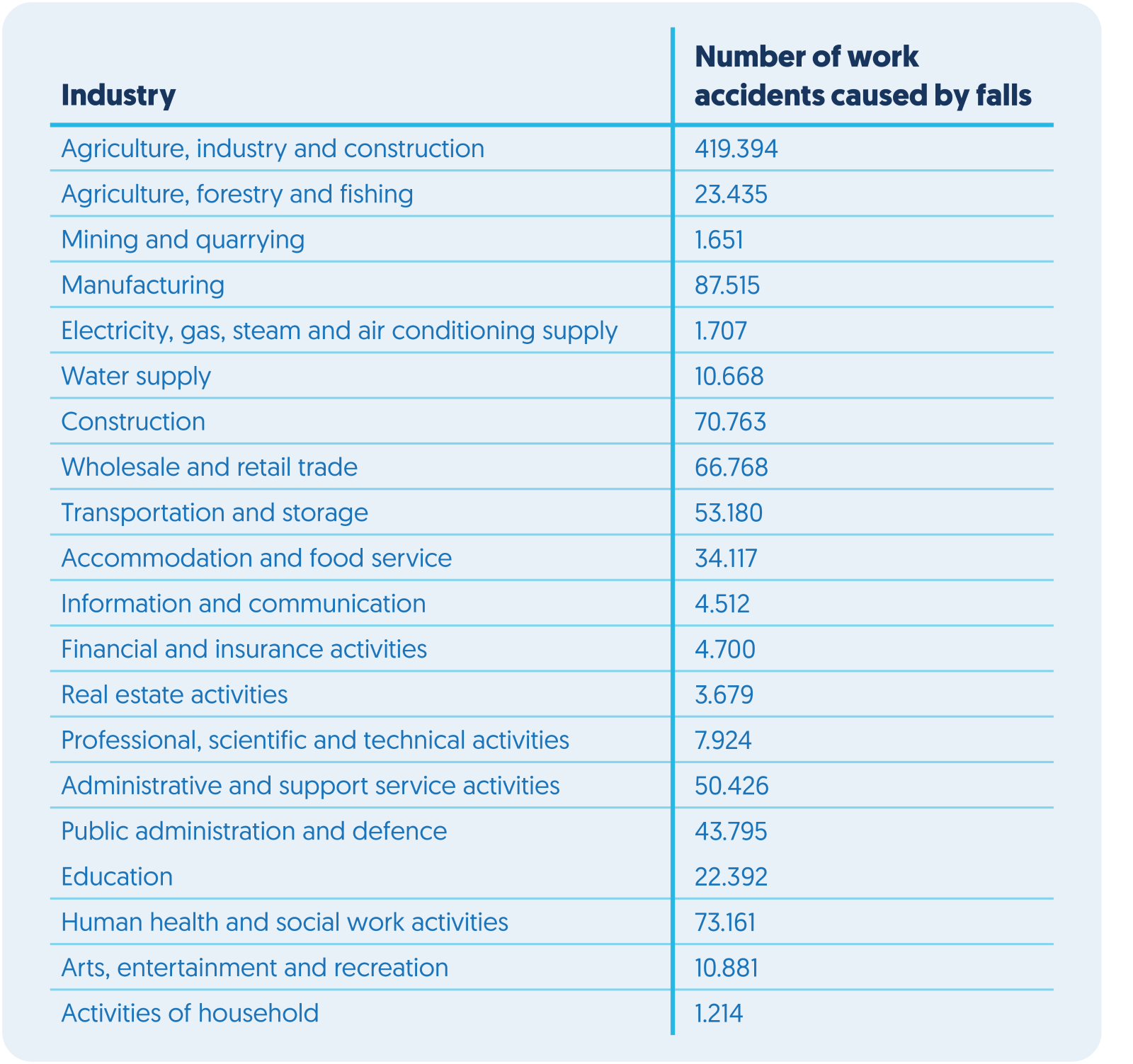
As you can see, working at height can be a dangerous activity if safety precautions are not taken. We’ll discuss the recommendations and regulations that apply to working at height a little later in this article, but before that, let’s see what exactly is considered “work at height”.
How tall does a workstation need to be for workers to require special protection against falls? Are there specific pieces of equipment that one needs to use when
working at a certain height? Are there particular working conditions that increase the risk of falling from height?
1. How is work at height defined?
In general, any activity that involves working above ground or floor level, where there is a risk of falling from one level to a lower one, is considered work at height, and
should be performed wearing proper fall protection equipment. In the UK, Belgium, Germany and Switzerland, certain obligations apply for activities carried out at heights of 2 meters or more, and in The Netherlands this figure
is 2,5 meters.
It is not considered work at height an activity that is performed on the level, on a permanent staircase or ladder, and it’s not treated as fall from height a
slip or trip on the level. However, if someone slips from a workstation that’s 3 meters above floor level, then that is classified as falling from height.
Although falling from a height of 2-3 meters doesn’t sound life-threatening, it can actually lead to serious consequences, as this kind of accidents can be disabling and even
deadly. In the European Union there were 521 deaths caused by falls from height in the workplace,
in 2014, 554 deaths in 2015, and 462 deadly falls from height in 2016.
A fall from height happens rapidly and the consequences cannot be minimized in the absence of fall protection equipment. Since Earth gravity is 9.8 m/s2, it takes one second
to fall 9.8 meters, and after that the body is accelerated, so after two seconds one is falling 19.6 m/s and so on. Thus, any worker carrying out tasks at a height should wear personal protection equipment (PPE) against falls.
CAUTION: Please be aware that the fall distance is not the same as the height of the work station, and also not the same as the height of the floor.
When measuring the actual fall distance, you need to take into consideration the length of your lanyard when deployed, the body height of the worker below the belt or harness.
What working conditions increase the risk of falling from height?
Although any activity carried out at height can be dangerous, there are some specific conditions that increase the risk of falling, and these include:
-
Working on trestles
-
Working on roofs
-
Working on a ladder
-
Working on a frame or elevated structure
-
Working near or adjacent to fragile materials
-
Working over a tank, pit or water
-
Working on cliffs or steep ground
-
Working on top of vehicles or trailers
-
Working on scaffolds
It is generally recommended to avoid working at height, but if it is unavoidable, the activity should be carried out from a safe platform, with suitable edge protection in place.
Poor edge protection, unguarded openings, items that are not secured or are poorly stored, as well as work in areas without guardrails or cover can increase the risk of falling
from height.
Ladders should not be used as work stations; they should just serve as means of gaining access to the workplace, and should only be used for short-duration tasks. If one
is performing light work of short duration, then using a ladder might be acceptable, as long as all possible hazards have been properly identified and the existing risks have been
evaluated.
Keep in mind that changing weather conditions, wind, rain and snow can also make it more dangerous to work at height. Also, as already shown, some jobs and industries
are at higher risk for falls. Construction, agriculture, maintenance, road transport, painting and decorating, window cleaning and so on, are activities that should only be carried
out with proper fall protection in place.
2. Types of fall protection equipment
Fall protection equipment can be classified into personal protection equipment (PPE) and collective
protection equipment. In situations where there is a risk of falling, appropriate equipment such as scaffolding, aerial
work platforms, safety nets and racks should be used. However, when collective safety measures are insufficient, PPE should be
worn.
The work at height environment dictates the type of equipment that one should use. To be effective, PPE needs to be comfortable to wear, needs to leave room for
manoeuvre, and needs to be adapted to the specific work and weather conditions. Also, before any piece of equipment is chosen, a thorough risk analysis should be conducted for
identifying the proper collective and personal safety measures that should be taken.
Given below are the main types of PPE and collective protection equipment, as defined by European standards.
Explore our full assortment of fall protection equipment, including harnesses, life lines, fall arresters, safety nets,
grips and hooks.
See the assortment
Personal protection equipment
Personal protection equipment includes fall arrest systems, positioning systems, suspension systems and retrieval systems.
Fall arrest systems
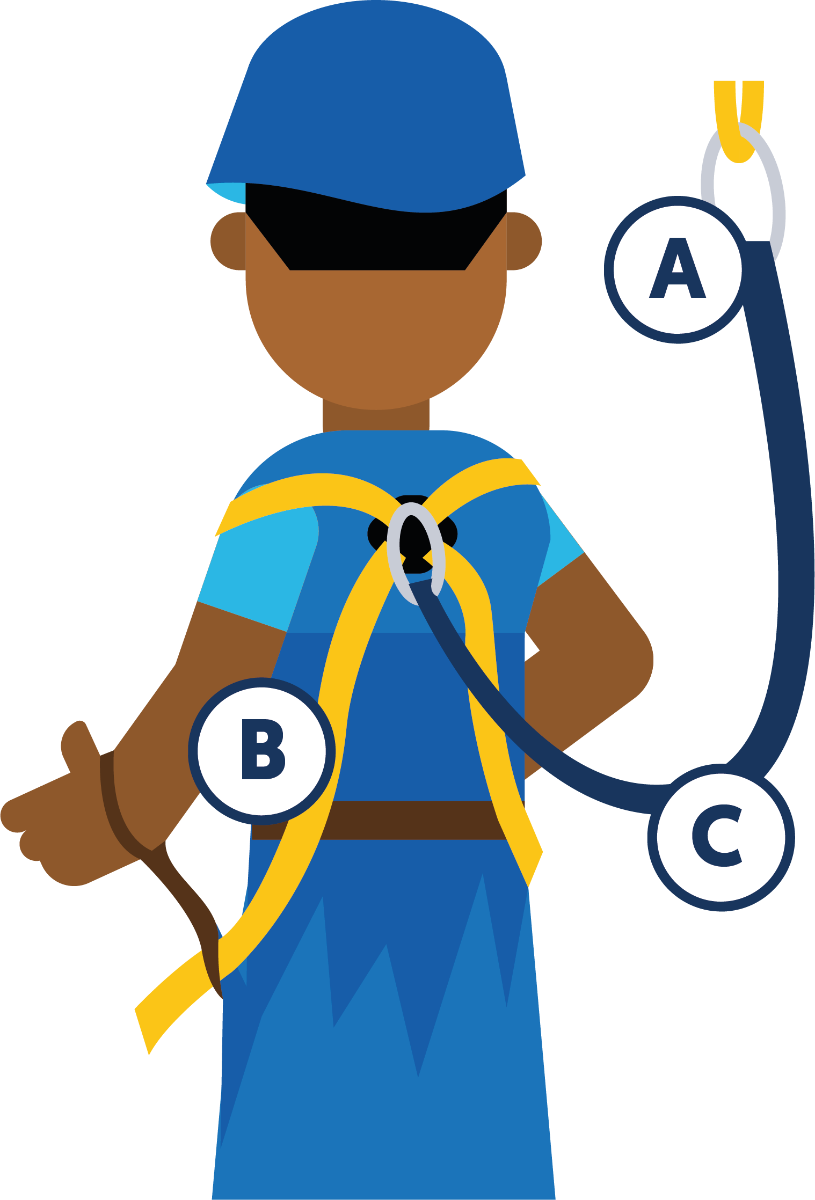
Fall arrest systems are systems used for stopping the falling worker in the event of a fall from height. These
are required whenever there is a risk for a worker to fall from an elevated position, or whenever an activity is carried out at
a height of 2 meters or more.
Fall arrest systems are designed to only come into service if a falls occur. Typical FAS consist of anchor devices, a full body
harness and connecting devices. For example, a full-body harness with a shock-absorbing lanyard or a retractable lifeline is a
very common combination.
The full-body harness distributes the forces throughout the body, while the lanyard or lifeline decreases the total fall
arresting forces. The anchoring device joints the connecting device to the anchorage point or tie off point, which can be an
l-beam, scaffolding or other structural point.
The harness is worn by the worker and mush enable him to work freely, without
restrictions, while providing sufficient protection against falls. The connecting devices can be shock absorbing lanyards,
self-retracting lifelines, fall limiters or rope grabs.
COMPONENTS OF A FALL ARREST SYSTEM
A full-body harness consists of interconnected shoulder and leg straps
with or without a body belt. The harness is designed to distribute the arrest forces over the body, to those areas that can
absorb the shock without significant injuries. At the same time, the harness should prevent the wearer from falling out of the
assembly
The full-body harness is connected to the lanyard or lifeline, and keeps
the worker in upright or near upright position while working and in case of a fall. This piece of equipment should not interfere
with other fall arrest system components and should leave the worker’s hands free.
Our recommended products



MILLER H-Design 2-point harness mating web loops S
REMA KTP-01 3 in 1 harnasset
TRACTEL Harness, HT Electra
ERIKS item #: 13229324
ERIKS item #: 11621450
ERIKS item #: 12640085
Buy now
Buy now
Buy now
The connectors are the components that connect all the pieces of the fall
arrest system, so they link the body harness to the lanyard or lifeline, and the lifeline to the anchorage points. These
connectors need to be strong enough to withstand the fall arrest forces, but still small enough to fit in the fall arrest
systems without bothering the wearer.
Connectors come in different shapes and are designed to stay locked in case of a fall. Carabiners, D-rings, O-rings, self-locking
connectors, snap hooks are some examples of connectors used for linking together the elements of a fall arrest system. Please note
that snap hooks and carabiners have to be self-closing or self-locking in order to be suitable for these systems.
Our recommended products



TRACTEL M51T Connector, Aluminium, Hook, 60 mm.
TRACTEL M10T Connectors, Steel S/Gate
TRACTEL As19-0.6 Anchor Sling
ERIKS item #: 12511732
ERIKS item #: 12492374
ERIKS item #: 12511743
Buy now
Buy now
Buy now
The lanyard is a flexible cord of a determined length used in conjunction
with a shock absorber, or including an energy-absorbing piece. It connects the body harness to the anchorage point or to a static
line, and may or may not be adjustable in length.
Although most lanyards are individual cords, there are also twin lanyard systems where two separate lanyards are connected
together in a system that allows the user to remain protected when moving from one anchorage point to another. This type of
lanyard is called “100 percent tie off”, “twin tail”, “Y lanyard” or “double lanyard”.
Lanyards come in many sizes and materials, for example nylon rope lanyards, wire rope lanyards, synthetic web lanyards
etc., each of these having specific applications. Please be aware that is it not recommended to connect two lanyards to one
another if you need a longer connection between the anchorage point and the body harness. In such cases, you should use a longer
lanyard or a lifeline of adequate length.
Our recommended products



MILLER Shock-absorbing lanyard A3 forked screwgate karabiner
MILLER Fall arrest lanyard edge tested 1 twist
REMA KM vanglijn FS150/14mm
ERIKS item #: 13229316
ERIKS item #: 13229314
ERIKS item #: 11621416
Buy now
Buy now
Buy now
The shock-absorber or energy absorber is the component of a fall arrest
system that limits the arrest forces applied to the user’s body in the event of a fall. It can be incorporated in the lanyard or
added as a separate component. It is a must for the shock absorber to be fitted correctly and used as per manufacturer’s
instructions, otherwise it may fail to deploy correctly in the event of a fall.
Please note that energy absorbers have expiration dates, meaning that they should only be used for the period of time
indicated by the manufacturer. After that, it is recommended to avoid using the absorber, even if it is intact and was never
deployed for arresting a fall.
Lifelines are flexible lines made of synthetic materials or rope, wire
or webbing, which run vertically or horizontally, as connections between anchorage points and the workers. They can replace
lanyards, depending on the job. Lifelines have to be properly maintained and stored, to avoid abrasion or damage along their length,
and should be strong enough to support the weight of the worker plus the arrest forces, in case of a fall.
A particular type is the self-retracting lifeline (SRL), which consists of a cable or tape wound around
a drum. This device acts like a car seatbelt in the event of a fall, meaning that when a fall occurs, the cable or tape is pulled
out of the casing, and a brake is applied to the drum, stopping the wearer from falling. Most SRL have integrated shock-absorbing
systems, therefore do not need an extra energy absorber connected.
Our recommended products



TRACTEL Blocfor 10 Aes G M46-M10 Ce
MILLER 2M Web self-retract lifeline twist lock
MILLER Lifeline Falcon self-retracting galvanised 10m
ERIKS item #: 12466125
ERIKS item #: 13229317
ERIKS item #: 13229319
Buy now
Buy now
Buy now
Positioning systems
Positioning systems are systems and pieces of equipment that hold an operator in his place of work, while
leaving his hands free for work. These systems are activated whenever the worker leans back, but are not designed for fall arrest
purposes. This means that such systems only restrain a person in a hazardous work position and reduce the risk of falls, but
do not eliminate it. Thus, it is recommended to use a back-up fall arrest system whenever using a positioning system.
A typical positioning system includes an anchoring device, a full body harness with a position belt and connecting devices, such
as work-positioning lanyards.
Suspension systems
Suspension systems act similarly to positioning systems, being designed to lower and support a worker,
allowing a hands free work environment. They are also not designed for fall arrest, therefore a back-up fall arrest system must
be used in combination with suspension ones.
A typical suspension system consists of anchor devices, two ropes – one equipped with a descender and one equipped
with a rope grab, and a full body hardness. Such systems are used for example in the window washing and painting industries.
A rope grab or fall arrestor is used when workers need to move vertically, and is positioned between the lifeline
and the lanyard, sliding freely on a vertical rope or on a rail or lifeline. In case of a sudden movement such as a fall, the
device grabs the lifeline and holds it firmly, arresting the fall. Retractable lifelines have rope grabs incorporated.
Retrieval systems
Retrieval systems are used for retrieval in the event of a fall. Rescue manoeuvres and evacuation equipment for
retrieving an injured worker from a high access position should be included in the pre-planning of work at height operations and
should be taken into consideration when developing a fall management program. Such systems consist of rescue and evacuation devices, such as chest harnesses.
Work restrain systems
Work restraint systems can also be used for preventing workers from approaching a position from which they
could fall. Such systems include anchor devices, work resistant belts or full body harnesses, and connecting devices such as
restraining lanyards.
Collective protection equipment
Collective protection equipment is sometimes the only protection needed against falls. For example, guardrails that
are placed at the roof edges may be enough in some cases, as they offer 100% fall prevention, so workers don’t need PPE. In such
situations where passive protection is used, workers only need to stay inside the rails to avoid falls. Guardrails can be installed
on a permanent or temporary basis, and the type of roof construction has to be taken into account for choosing the proper system.
Horizontal lifeline systems consist of a series of anchor points connected by wire rope, the rope track following the
contour of the roof. The worker hooks up once, and uses a slider or runner that goes along the track, following the user. Such
a system offers freedom of movement while ensuring safe working conditions at height. If needed, the anchor points and rope system
can also be used in the centre of the roof, in this case the solution being more cost-effective.
Another method to ensure collective protection against fall is to install a temporary scaffold to support
the workers carrying out activities at height. This system is usually modular, made of a series of pipes or tubes, and enables
workers to easily carry materials at height, if performing construction or maintenance activities. Scaffolds are commonly made
of metal or aluminium, the latter being more lightweight and durable.
Safety nets are also used as collective protection equipment against falls. The nets are positioned
beneath the worksite, covering the entire floor and being fixed to the structure. In some cases, the net is used only for covering
a fall-catching area.
NOTE: In a lot of cases, accidents and falls occur not on the work platform itself, but on the equipment used for accessing the workplace. For example, mobile access towers and elevating platforms, suspended access and positioning devices and portable ladders can lead to falls from height, if manoeuvred improperly. If a worker has not descended from a mobile access towers and the device is moved to another location, there’s an increased risk of falling.
3. Standards and regulations for fall protection equipment
The EN 365:2004 Standard – Personal protective equipment against falls from a height – General requirements for instructions
for use, maintenance, periodic examination, repair, marking and packaging – requires manufacturers to emphasize the importance
of regular inspections that serve to establish that the product is operating properly.
Regular maintenance is also recommended, depending on the type, frequency of usage and environmental factors. Maintenance
activities should be carried out at least once a year, by an authorized person, in accordance with the procedures established by
the manufacturer.
Other standards exist for specific PPE, as shown in the table below:
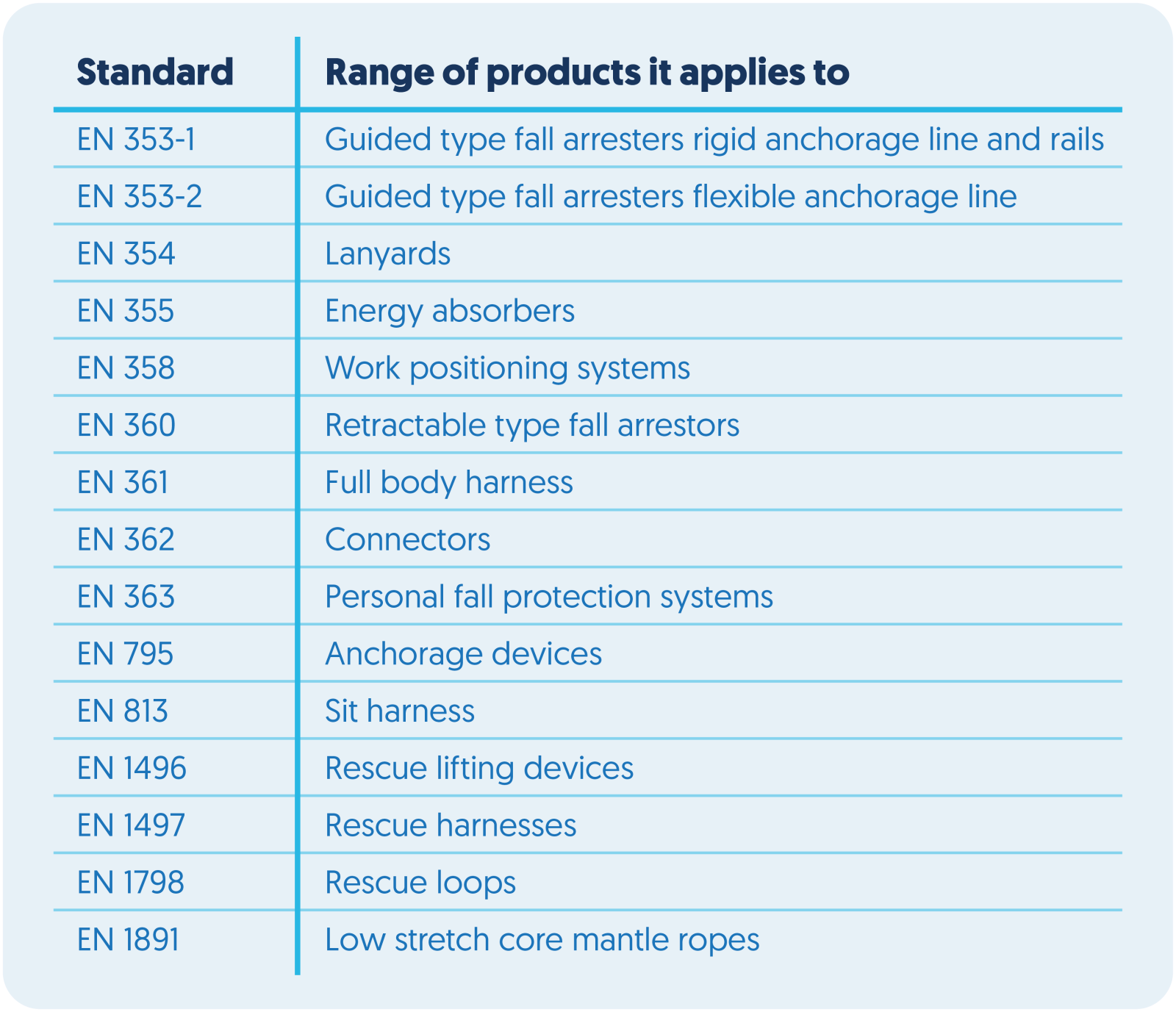
All PPE used for protection from falls comes under Category III equipment of the European PPE Directive 89/68/EEC,
therefore all equipment must be CE marked and conform to certain minimum requirements.
4. Risk assessment and safety principles
Before starting any activity at height, one should asses all potential risks, including the workers on the ground that may be
affected by falling objects. Whenever possible, work at height should be avoided, however when that’s not possible, the employer
should make sure that all work is properly planned and organized, and appropriate equipment is selected and used.
There are two main types of risks workers are exposed at, when working at height:
Risks while accessing the workplace or workstation
Risks while working at height
The employer is responsible for workers’ safety, therefore he should ensure that as much work as possible is performed
on the ground. If work at height can’t be avoided, it is preferable for a work platform to be set up in the vicinity of the work
area, to reduce the height. If parts of a machine can be dismantled or assembled on the ground, then workers should avoid
performing such activities at height.
When assessing the risks, one should look at the workplace – what machines are there, what materials and equipment,
how does the environment look like, and should search for potential sources of risk – for example, working close to a void, or on a
fragile surface, or at height. Then, one should evaluate the tasks, duration, frequency and posture of the workers during the
activities performed at height. Also, they should asses the competence and experience of the workers.
As much as possible, the work conditions should be adapted to the workers and the risks should be eliminated. At the
same time, an overall prevention policy should be developed, so that all workers know how to act to avoid or in case of an
accident.
Although wearing personal protection equipment can make one feel safer and may seem like a simpler solution for
preventing accidents, it is not always necessary for workers to wear PPE. Moreover, collective protection measures can be more
efficient in preventing accidents in some cases. For this reason, it is a general safety principle to prioritize collective
protection over personal one.
A practical example is the replacement of individual access equipment such as ladders with collective equipment such as
scaffolds. Or for example in case of workers who clean windows, using a cradle or a mobile elevated work platform makes more
sense and is much safer than asking each worker to use suspended, personal protective equipment.
A risk assessment framework could look like this:
- Step 1: Identify the risks – slipping or tripping, fire, work at height, chemicals, moving parts of machinery, electricity, fumes, manual handling of loads etc.
- Step 2: Identify the groups of people who might get injured – workers, public, cleaners, contractors, maintenance workers etc.
- Step 3: Take precautions to control the risks – eliminate or minimize risks, provide training and information, use appropriate systems, equipment and work procedures.
- Step 4: Record all the findings
- Step 5: Review and evaluate all measures taken for eliminating or controlling the risks.
Below you can find some principles for selecting the proper collective or personal protection equipment based on the
height hazard.
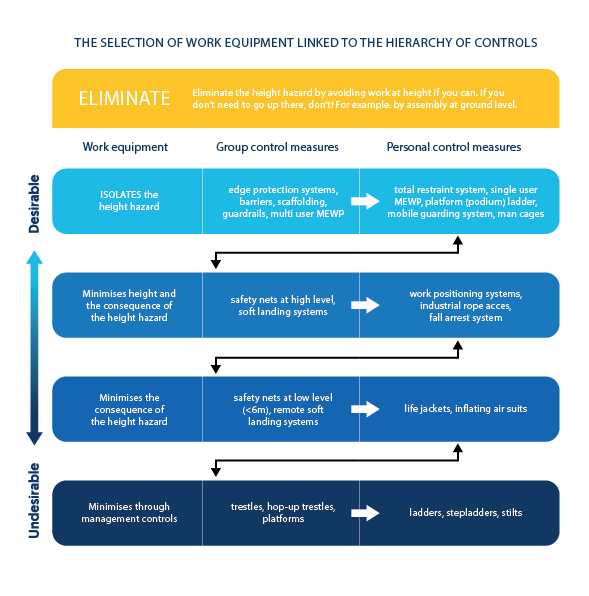
5. Selecting the right equipment and anchor points
To keep the risk of falling from height at a minimum, proper means of work, anchor points and protection equipment should
be selected. For example, PVC pipes, decorative elements, structures made of fragile materials, sharp edges and corners should
never be used as anchor points.
A safe anchor point should support the person attached while keeping the personal protection equipment intact. Ideally,
the anchor points should be installed as permanent or temporary fixtures to a building, or placed around a suitable structure.
They should be positioned above the worker, to ensure that the slack in the lanyard is minimal.

Besides anchor points, lifelines are also used as PPE when working at height. These are flexible or rigid lines connected
at least on one end to an anchor point. They serve as connections between anchor points and workers who use personal fall
prevention systems.
Lifelines should not interfere with other pieces of equipment, therefore they should be installed in a way that doesn’t
create any falling, slipping or tripping risks. Also, they should allow the worker to wear his safety equipment comfortably.
Lifelines should have safety ratings high enough to withstand the forces generated in the event of a fall.
Lifelines can be classified into three main groups:
- Vertical lifelines
- Horizontal lifelines
- Self-retracting lifelines
Vertical and horizontal lifelines are used with special devices that allow workers to travel alongside lifelines during
horizontal, upwards or downwards movements. For example, travelers are used with horizontal lifeline systems, while rope grabs
are used for work positioning systems. Ascenders and descenders are used for rope access systems, and guided type fall arrestors
are used for vertical lifeline systems.
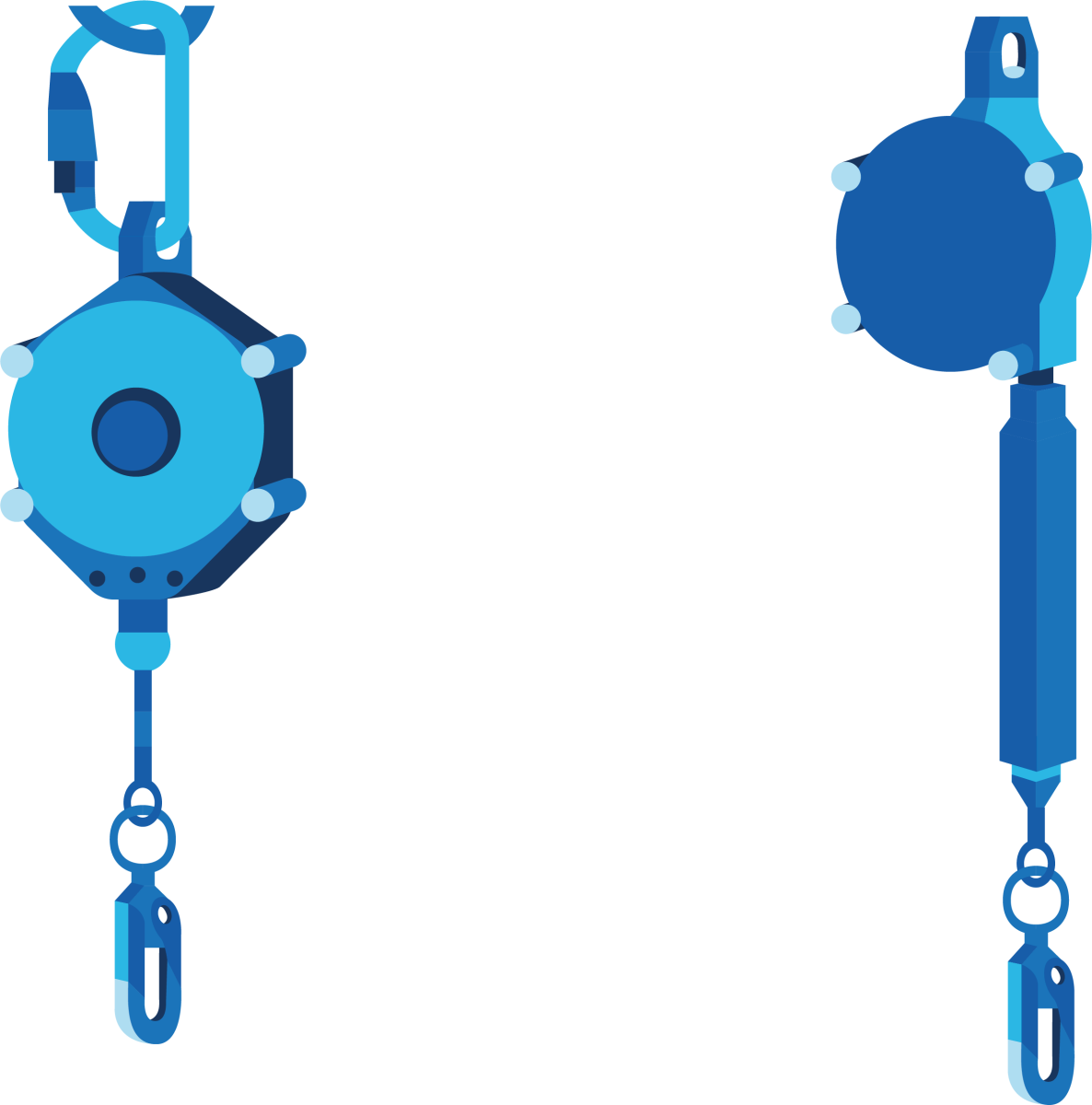
Self-retracting lifelines (SRL) are particularly interesting, as they include a spring-loaded reel that ensures the
shortest possible length of lifeline between the user and the reel.
Lifelines should never be used in the horizontal plane and
should not be attached to horizontal lifelines or to lanyards, as this would extend their length, and potentially make them
inefficient for the given fall distance.
Self-retracting lifelines should be used by a single worker at a time, should be certified and installed by a specialist,
according to manufacturer’s specifications.
Considerations for fall arrest systems
There are 3 fall factors in fall arrest that relate to the position of the anchor points and are used for determining the fall
distance of a worker, as well as for ensuring that there is no risk of contact with the lower level in the event of a fall.
Fall Factor 0 – In this case, the anchorage is overhead, and the lanyard is taut between the anchorage point and the worker. The fall clearance
is reduced as shown.
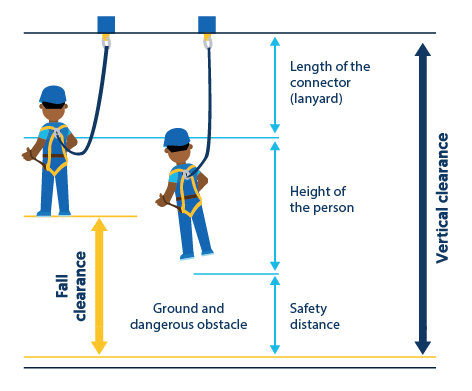
Fall Factor 1 – The anchorage point is at the same level or above the harness attachment point, allowing a fall equivalent to the length of the
lanyard, before the energy absorber deploys to arrest the fall.
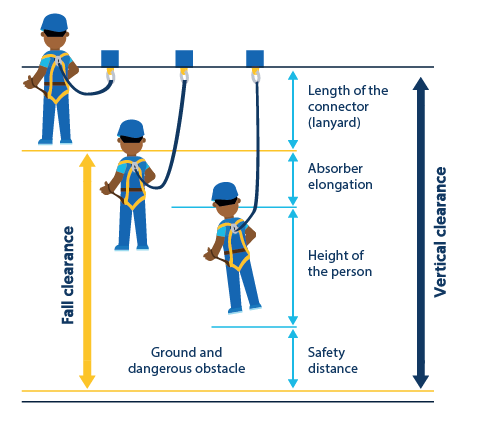
Fall Factor 2 – In this case, the anchor point is at or below feet level, allowing a fall equivalent to twice the length of the lanyard before
the energy absorber deploys and arrests the fall. It is very easy to choose the wrong length of a lanyard in such situations, so the recommendation is
to always choose an anchorage point at shoulder level or above (FF0 or FF1), if possible.
NOTE: When possible, a higher anchorage point should be chosen, as this will reduce the fall distance and reduce the risk of injury due to impact forces. Also, the lifeline should be anchored vertically over the workplace to avoid the pendulum effect. If it’s not possible to use an anchorage point above the working station, it is preferable to choose two anchorage points (one of each side) instead of only one side anchorage point, to prevent swinging.
For low level work, a self-retracting lifeline might be more suitable than a lanyard for fall arrests, as it stops a fall in centimeters. Unlike it, a shock-absorbing lanyard cannot prevent a worker from hitting an obstacle below in case of low-level work. Let’s look at an example to understand fall arrest systems better.
Let’s say you are performing work at a height of 6.5 meters, and you want to use a lanyard of 2 meters. The minimum vertical clearance required between the
anchorage point of the lanyard and the lower level is calculated as follows:
Length of lanyard + Fully activated energy absorber + Body height from feet to harness attachment + Additional safety clearance = Minimum vertical clearance
Example:
2 m lanyard length + 1.75 m energy absorber + 2 m body height + 1 m safety = 6.75 m
We therefore see that in case of work performed at a height of 6 meters, a lanyard with an energy absorbing system is not a good solution. In this case,
we should use a shorter lanyard, of 1.5 meters for example.

Please note that fall arrest systems are not risk free. Even if the systems have the proper length to arrest the fall and prevent the worker from hitting the lower floor, there are still two types of hazards that can occur, and these are the swinging back and swinging down, caused by the pendulum effect.
The swinging back occurs when the worker falls from a perpendicular edge and swings back into the building structure, colliding with the existing obstructions. This risk should be carefully evaluated before choosing a fall arrest system, and if the risk does exist, then the used of different protection means might be necessary.
As for the swinging down, this occurs when the arrest line extends diagonally from the anchor point. If the worker falls, the fall arrest system slides back along the perimeter of the roof, until the arrest line is at a right angle with the edge of the roof. In this case, a line that’s too long can cause the worker to hit the ground, and if the edge of the roof is very sharp, the arrest line may break.
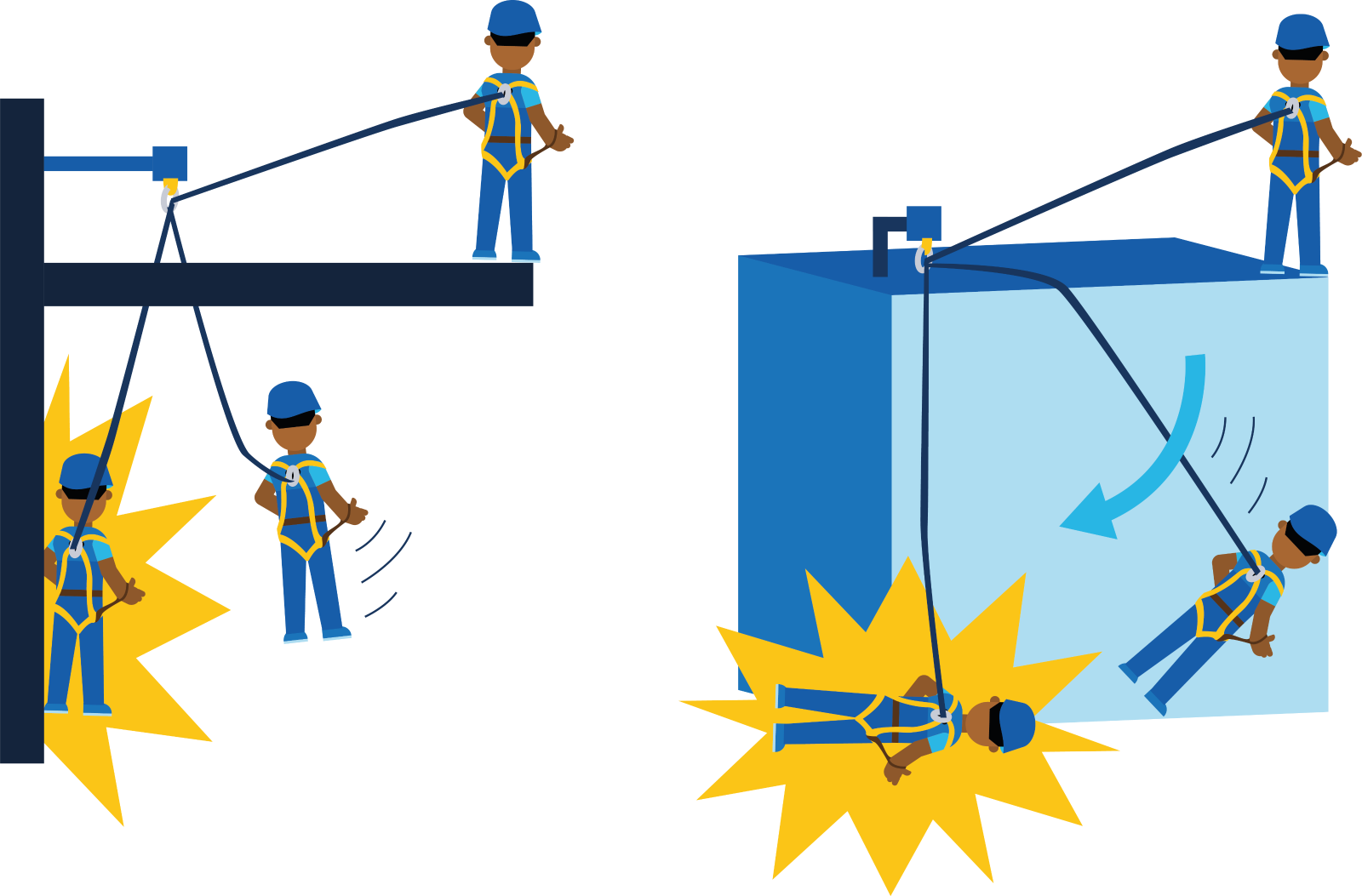
Considerations for suspension and positioning systems
Work positioning systems aren’t designed to arrest a fall, and should be used only when it’s not possible to employ safer means to access the work at height. These systems include a belt that supports the body and works in tension or suspension, leaving the worker’s hands free. The belt is connected to a positioning lanyard, the anchor point being at waist level.
Since the anchorage points are usually structures like vertical rods or ladders, it is recommended to use an independent retractable lifeline along with the belt. The lifeline can be attached at shoulder level and connected to an anchor point above the worker’s head.
If using positioning systems, it is crucial to make sure the workers are competent in the technique and do not work alone. Also, it is necessary for the systems to be installed only in locations where prompt assistance can be offered in case of a fall. The equipment and all anchorage points should be thoroughly checked before using them, and a backup system should be used to decrease the risk of injury in case of a fall.
Considerations for travel restrain systems
A travel restrain system consist of a full body harness or a restrain belt, attached to one or more lanyards, which are also attached to a static line or to anchorage points. These systems retrain the travel possibilities on roofs and are portable, easy to install and remove and lightweight. Since they are not designed for fall arrest, they should be used in conjunction with fall arrest systems.
Travel restrain systems should not be installed on fragile roofs, and if access to roof corners is required, the workers should be connected to two or more ropes or anchor points. The movement of the worker should be restrained when accessing corners, so that a fall cannot occur.
Unlike lifelines, travel restrain systems can be used by more workers at the same time, therefore anchorage points should be chosen only from those
capable of withstanding at least two times the maximum total load likely to be applied. Thus, for these systems, the anchorage points should be designed
for additional loading. All workers using the system should also wear fall arrest PPE.

6. Recommended inspection before starting the work
People working at height should be trained and competent and the equipment should be inspected before starting the activities. One should check for fragile surfaces and risky spots, and should avoid working in or near such areas. Common examples are roof sheets made of fibre or asbestos cement, but also working underneath scaffolds made of such materials.
It shouldn’t be neglected that working at height can add to other risks such as slipping or tripping hazards, or electrocution when the work is performed underneath or close to overhead cables.
If ladders are used, they should be in good condition, erected at the correct angle and secured at the top or footed. Also, they should be positioned close to the work spot, to avoid over-reaching, and should be protected at the base to avoid other workers bumping into them. In case of stepladders, they should be spread to their full extent, locked off and used by a single worker at a time.
If mobile elevated work platforms are used, the workers should always wear safety harnesses and should only use the platform on firm ground. The position of the platform should take into account changing weather conditions such as strong wind or rain, as well as beams, hanging obstructions and power cables.
Belts, lanyards and harnesses should be inspected before being used for broken fibres, pulled stitches, frayed edges, cuts or chemical damage. Loose and distorted buckles as well as holes in the straps can compromise the efficiency of a belt or harness. Buckles should also be inspected for sharp edges and corners, and the rivets should be tight and flat against the material, not bent.
Ropes should be inspected for cut, broken, worn or fuzzy fibers. If weakened areas are noticed or if the diameter of the rope is not uniform throughout, the rope should be replaced, as there’s an increased risk for it to break. Snaps should also be checked for distortions, cracks or corrosion.

Do you have questions about our products?
For personal advise and product knowledge, visit an ERIKS location near you or contact our product specialists.
Find a service center | Call our Customer support | Send us an e-mail






